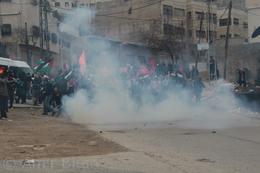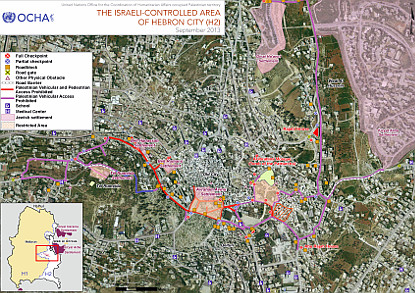The Settlers Take Over the Rajabi House in Hebron: Apartheid in Motion The Israeli High Court of Justice ruled in favor of Israeli settlers who fraudulently “purchased” the Rajabi House in the H2 area of Hebron, thus giving them a green light to execute the next step in their campaign of dispossession and control in the heart of Hebron.
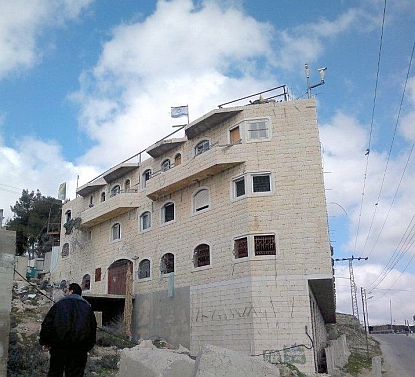
Why is the Rajabi House so important for the settlers? The House is intended to be used as an outpost connecting the Kiryat Arba settlement with the four settlement blocs in the heart of Hebron. Take a look at the map, which shows how a series of tiny settlements can shut down life in Hebron. A couple of hundred settler-masters enjoy total immunity and harass Palestinians on a daily basis. This has no better name than apartheid. (Smaller Map – Click on it to get a larger map so you can notice the details).
Connecting These Settlements Makes The Area Off-Limits to Palestinian Movement. The red line on the map marks the zone that is currently off-limits to Palestinian pedestrians and vehicles. It connects the “Bet Hadassah”, “Bet Romano” and “Avraham Avinu” settlements. The purple line indicates the road that is off-limits to Palestinian vehicles. It connects the “Avraham Avinu” settlement to the Rajabi House and from there – the Kiryat Arba settlement. This is how key traffic arteries, including Shuhada street, become roads “for the masters only.”
Even today, the lives of the residents of Wadi Al-Husein (on the right side of the map) are under daily siege. In the past, Wadi Al-Husein was a peaceful rural neighborhood in Hebron. Now the lives of the residents are overshadowed by Kiryat Arba, which borders them on the east, and the “Givat Avot” settlement north of them, while the road beside them is off-limits to Palestinian vehicles. What does that mean for everyday life? Ambulances, fire-engines and garbage trucks cannot enter the neighborhood; the neighborhood being off-limits to vehicles makes it difficult to evacuate people who need hospitalization, to conduct maintenance, to shop for groceries and other necessities, or to conduct construction. The neighborhood is being strangled. Now, with the expected takeover of the Rajabi House by settlers (on the left of the neighborhood), the neighborhood will be surrounded by settlements on all sides.
Every tiny settlement is surrounded by Israeli security forces, turning the lives of its neighbors into a living hell. The more the colonization process advances, the more the settlements separate the Palestinian families that continue to hold on to the city center. They break down the essential fabric of social relationships in the city, among neighbors and relatives. Under the IDF’s protection, they are turning Palestinian houses into enclaves stuck between the various masters’ colonies.
In this way, for instance, they make an entire street off-limits to Palestinian city residents to guarantee the movement of the Israeli settler masters:
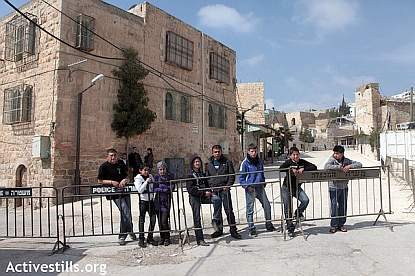
That way, the masters can walk around freely in the streets, harassing Palestinians (in the photo: Purim 2013):
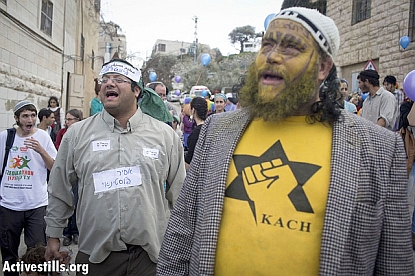
Is the purchase of the Rajabi House legal? All settlements in the occupied territories are illegal. Whether it’s a land expropriation by the Israeli state or a land purchase between private individuals, purchasing land in the occupied territories to advance the colonization process is an act of theft whose purpose is to pull the rug out from under the very existence of the Palestinian people. Beyond that, in Hebron as in other places in the occupied territories, Israeli settlers operate using a network of straw men and acts of fraud. In the case of the Rajabi House, it is a well-known and beyond dispute that the house was purchased fraudulently using a Palestinian straw man. For the Israeli courts, this is no reason to void the purchase. Asaf Nechmad, a former Secret Services (Shabak) operative, was a key figure in the purchase affair, as in other cases. He is the operative whose crimes in Silwan were already well-described by Meron Rapaport in 2005.
What is about to happen now? In the Rajabi House and its environs, a continuous nightmare is around the corner for the Palestinian residents. In a report published by Badia Dweik, a Hebron activist against the settlements, he interviewed several people who have experience living in the shadow of the settlers there. Majdi Al-Ja‘abari lives a few meters away from the Rajabi House. He explains that if the settlers return to this area of Hebron, they will turn the neighborhood into a living hell for its residents with ceaseless acts and harassment, as they have in the past. Bassam Al-Ja‘abari, who makes a living as a shoemaker, also lives only a few meters from the Rajabi House. He describes how the settlers attacked the houses of their Palestinian neighbors with stones, organized protests of incitement against Arabs, demanding to expel them from the area.
Al Ja’abari told Dweik how, while building his house, he was forced to stop work several times because of the pressure of the settlers and their greater presence in the neighborhood. The presence of settlers is always accompanied by the IDF and Israeli police. The Israeli Civil Administration even notified Al-Ja‘abari in May 28th, 2012 that he must halt construction, despite the fact that he had a valid construction permit from the Hebron municipality. Eventually, the occupation authorities allowed him to continue construction, but only after the end of Eid Al-Adha celebrations. This decision was reached mainly thanks to the active involvement of human rights organizations and political activists.
But beyond what is around the corner for the close neighbors of the Rajabi House, the consequences of the take-over are severe for the entire city of Hebron. The house will become a base for settler attacks against the Palestinians. What is expected is that the presence of the settlers will become an excuse for additional restrictions on the residents of the street and the nearby Wadi Al-Husein neighborhood. The take-over of the house is an additional stage in the settlers’ attempt to break into the heart of the city of Hebron and its historic city center. The anticipated damage to the local Palestinian economy is clear: stores and markets will be forced to close. The commercial center in H2 has become a ghost town after the forced closure of dozens of Palestinian factories and shops.
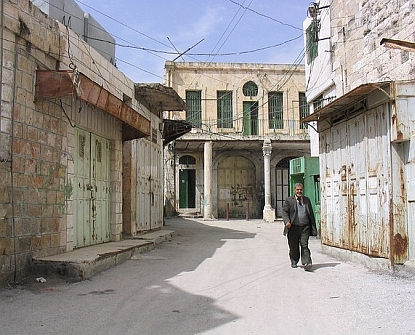
In short: this is a war. The settlers are leading it, the IDF gives them protection, the Israeli courts legitimize the theft, and the Israeli authorities promote it. This is how apartheid in motion looks like.
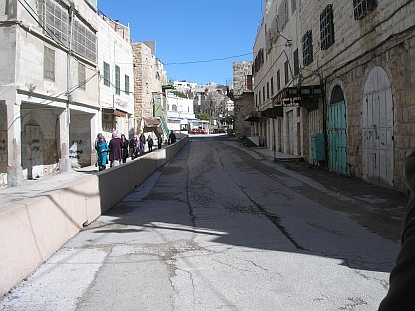
Map source: Report of the UN Office for the Coordination of Humanitarian Affairs in the Occupied Territories (OCHA)

